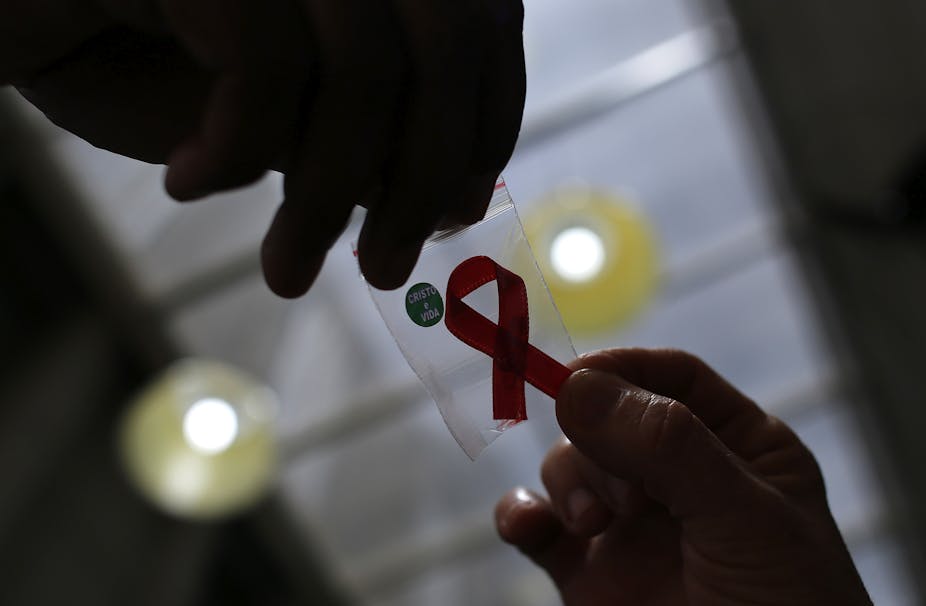South Africa has made incredible strides providing anti-retroviral treatment to millions of people since 2004. HIV has been transformed from a grim and inexorable death to a chronic disease controlled with a cheap, safe tablet-a-day, rendering a person with HIV healthy and non-infectious.
Treatment is freely available at primary care clinics, administered largely through nurses. The indications are that South Africa is getting the majority of people onto treatment who need it.
As a result of this broad access, life expectancy has leapt up by a decade from 52.1 in 2003 to 62.5 in 2015. And while HIV still significantly contributes to the country’s mortality rate, the state-led HIV treatment program has had an impact on direct HIV-linked mortality.
But HIV prevention has little to celebrate in terms of success despite three decades of attention. Although overall incidence has shown modest decline, it is off a staggeringly high baseline. New infection rates among young women remain frightening. And lifetime incidence is high even among older women and men. This is despite significant resources focused on behaviour change and condom use.
Treatment milestones
South Africa currently houses almost one-fifth of the global HIV positive population. It treats more people than any other country with anti-retrovirals, consuming one-quarter of global generics.
The country has been heralded for its turnaround. Despite previous political obfuscation, political leaders have since shown sustained and significant support for HIV.
But anti-retroviral treatment is not perfect. Toxicities, although unusual, compromise adherence and lead to people falling off the program or developing resistance. Resistance means patients must move to more toxic and expensive second- and third-line drugs.
Treatment costs have plummeted, but it still consumes a huge percentage of health budgets. This is an ongoing and cumulative burden as more people start treatment, and live longer. The challenge is that certain groups, most notably men, continue to test late and access treatment in lower numbers than they should. Stigma is still alive and well, and treatment is often secretive. There is also concern about the levels of adherence support and of people being lost to the system.
Several new anti-retrovirals are being evaluated for use in the region. These will almost certainly cut costs, be safer and have more resistance “forgiveness”. And drugs that could help with adherence are being developed. Implementation of a single patient identifier – admittedly slow – also may allow better tracking of patient movement between clinics.
The numbers keep climbing
But infection numbers are still staggering and new infection rates remain high.
There is some debate about the precise incidence rate, but it appears that between 1% and 2% of South Africans are infected with HIV annually. Among women between 15 and 49, this is over 2%. The Centre for Disease Control in the US has merited this severe enough to justify pre-exposure prophylaxtics(PrEPs). This entails giving people anti-retrovirals to prevent HIV.
Pre-exposure prophylaxtics is new and exciting – and new formulations may be available in the next few years.
Historically, South Africa has invested heavily in education programs, condom provision, HIV testing, mother-to-child prevention and, more recently, male circumcision. It may have the highest condom provision rate in the world.
But the ongoing prevention disaster demands more attention, creativity, courage and focus within South Africa.
Tackling the problem
The final push against HIV requires a multi-pronged approach. Yes, South Africa needs to celebrate the victories of treatment. And it must ensure that there are continued resources to roll out anti-retrovirals as both an effective treatment and prevention strategy.
But the country needs to acknowledge that its prevention program isn’t enough. Some interventions, such as education programs, are often based on conventional wisdom and morality, rather than science. Many may not be working. Some, like male circumcisions and prevention of mother to child transmissions, work well. More aggressive scaling of circumcision programs, getting HIV testing into under-tested groups, especially men, and rapid initiation of anti-retrovirals is needed.
The vaccine, cure and other biological intervention should also be supported, while trying to work out who is most at risk and why, with better epidemiological and behavioural research.
In addition, a package of prevention services is desperately needed to address the vulnerability of young women that extends beyond education and condoms. A first big step would be offering pre-exposure prophylaxtics in a comprehensive package that includes HIV testing and contraception within schools. This group also needs to be prioritised for future interventions.
Politicians, parents and education officials need to get past their discomfort around these packages being offered in schools. Currently, condoms are not routinely allowed in schools, despite evidence of high levels of new HIV and sexually transmitted infection rates.
Other groups, including older women, men and marginalised groups, will need interventions that are creative and focused.
South Africa can be justly proud of its progress in HIV treatment. But the ongoing crisis of HIV prevention needs more focus, creativity and resources for research and programs. The country needs the kind of urgency and drive around HIV prevention that has given it a successful treatment program.

